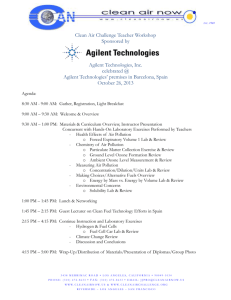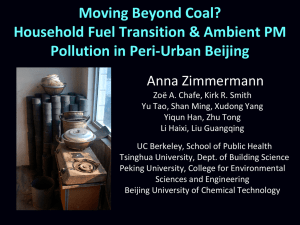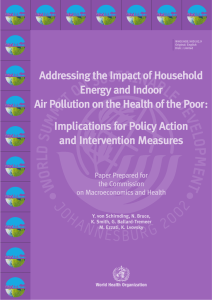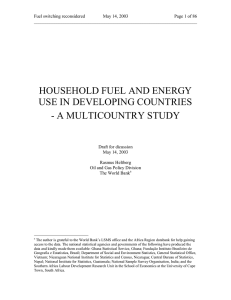Mitigation of air pollution and climate Change in China
advertisement
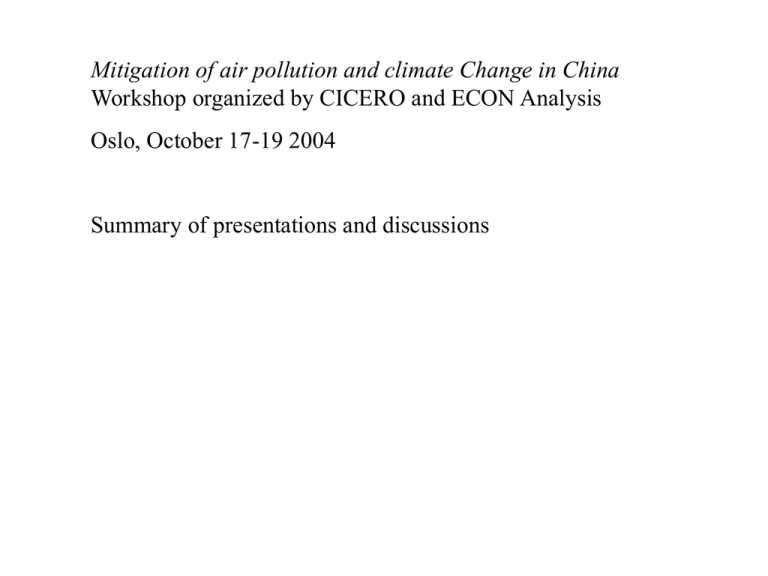
Mitigation of air pollution and climate Change in China Workshop organized by CICERO and ECON Analysis Oslo, October 17-19 2004 Summary of presentations and discussions Household behavior, indoor pollution and outdoor pollution - Is it a problem? What is size of problem? Measurement issues. - What is a good framework to discuss the problem? - What policies can we recommend, or recommend to study? The study of economic growth, trade, environment and policy - How to study this link? Economic-environment models, case studies, - Modeling results and lessons - How much can we trust the modeling results? Or, are there any robust lessons? Jonathan Sinton Survey of rural household stoves and fuel use in 3 provinces - each household use different stoves and fuels at the same time - despite big increase in LPG, biomass is still dominant, also high coal use - official data high dissemination of “improved stoves” but some questions about definition of improved and being correctly used • Is biomass a renewable that really has a lower GWP (global warming potential)? Or does it has high GWP when we include all elements? • Need regular national survey of household fuel use patterns David Streets • Black carbon (BC) is important for climate change AND for damages to health, materials and agriculture • Jim Hansen calc. that BC could be the 2nd or 3rd highest radiative forcing after CO2 and CH4 using ? time horizon • China has ¼ of world BC which is dominated by biomass burning • In China 10 mil. tons BC produced; ¾ from households, 10% from industry, 10% from transportation • But projections under most scenarios indicate BC from households falling to zero. Of this smaller future BC emissions they will be dominated by crop residues and fuelwood, instead of coal today. * To get this fall in BC may need to include it in climate agreements * Need information on BC emission factors to get a good estimate of total emissions. Eric Larson • Big majority of rural households use solid fuels • Rapid increase in LPG use but still small share, future increase may be constrained by world supply (high prices) • CH3OCH3 (DME) is a feasible alternative to LGP if combined by electricity generation and at P(oil)>$30/barrel • DME + electricity result in net energy savings • But at current LPG/DME price their growth will be limited, may consider subsidizing it. Keith Florig • Many countries have seen shift from solid fuels to cleaner fuels without govt intervention, just the effects of income growth. Can this also happen quickly in China? • Observed changes in behavior as Chinese income grew is not fuel switching but more energy use. Switching only at quite high incomes. Note, high income by increasing house size and more health care, reduces damages • Should identify all beneficiaries of solid fuel reductions to build support beyond immediate household members – educators worried about sick children, health dept trying to reduce public health spending, agriculture dept worried about low output from sick farmers, etc… • Focusing only on GHG effects may leave out consideration of some policy choices that benefits all these local stakeholders Kristin Aunan • What do we lose in climate analysis if we ignore China’s biomass use, and other household fuels? • HH alone is responsible for 70% of China BC, 30% of CH4, 40% VOC,…. • Effect of BC on climate not well understood, preliminary estimate indicate household BC radiative forcing is greater than CO2 and tropo. O3. Ramon Ortiz • Add information on household pollution to World Bank China Environmental Cost Model • Hard to measure indoor pollution effects, need to better understand relation between indoor and outdoor concentrations. • Literature review to gather information on solid fuel use, identify health endpoints that are strongly or moderately linked to indoor solid fuel use, best estimates of odds-ratio; identify effects for separate demographic groups. • ? Mullahy scepticism of such binary studies of health effects Pan Xiao-chuan • What are the indoor air pollutants in urban and rural households, and what are their effects? • In urban hh, dominant pollutants are formaldehyde, VOC, allergens, NH3. Measured concentrations exceed govt. standards. Stat. signif effect on asthma. • Effect on leukemia not clear, more closely linked to smoking. Fang Jinghua • Characteristics of household fuel use and pollution levels in Taiyuan. • LPG used for cooking, coal for heating. • Very high conc of PM in both seasons, exceeding national Standards • Coal worse than briquettes • Big contribution to conc from outside sources Li Liu • Dispersion modeling of Taiyuan





